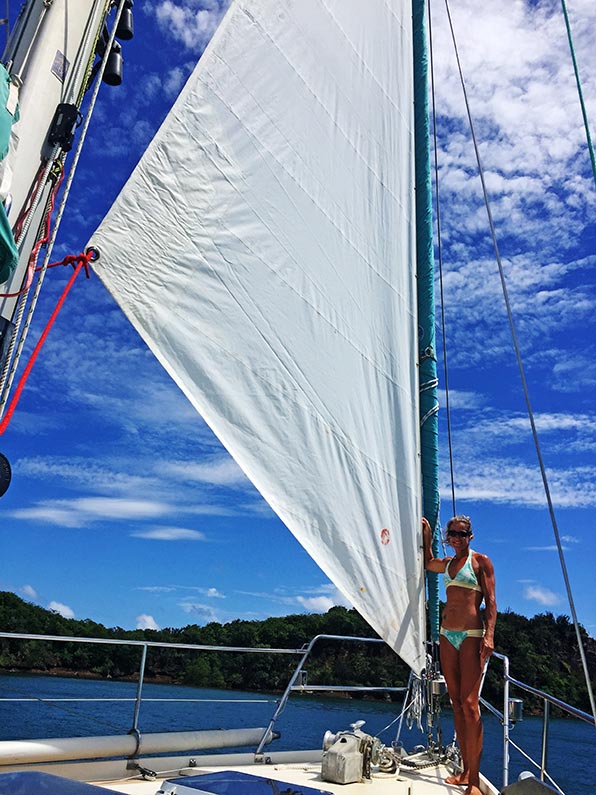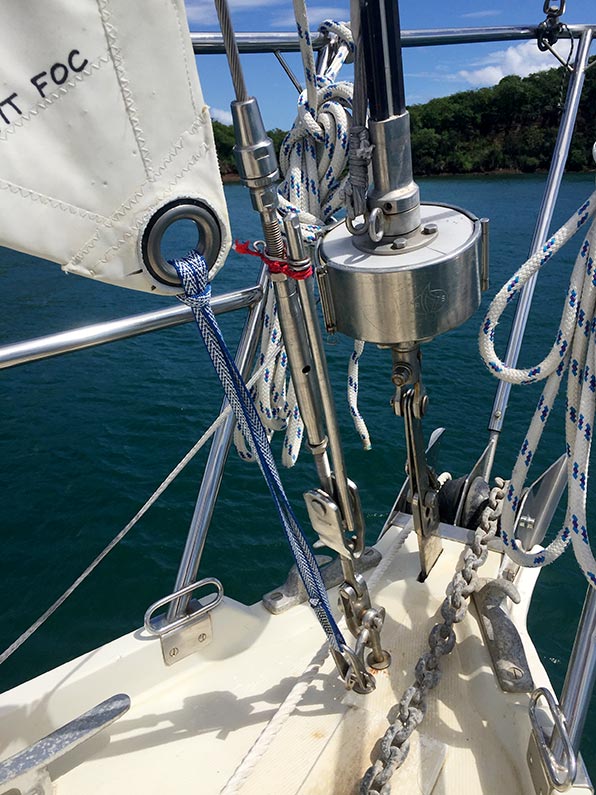Sail stuff
Even since we started cruising, and I had the opportunity to check out a number of different boat designs, I have been envious of those with cutter rigs. It always seemed to me that boats with two forestays, that had the option of flying their genoa in light air, or a smaller staysail when the wind piped up, had a big advantage. Even better were the true cutter rigs that allowed you to fly both headsails at the same time!
While by no means an actual cutter, Frost does have a removable inner forestay, and the boat came with 3 different hank-on sails to fly on it. Yesterday, with some relatively light winds in the anchorage, we decided to set one of the smaller jibs to see how it all worked. I was quite pleased with the results.

This is the smaller of the two hank-on jibs that we have.
Frost also came with a downwind butterfly sail that hanks on to the removable stay.
One of the questions I had before we started was how to best run the sheets back to the winches. What we did yesterday was remove the genoa sheets from the jib-track, coil them, and then bring them forward. We then moved the car forward on the track and ran the jib sheets through it, leading them inside the shrouds as opposed to the genoa sheets which run outside. Is that the best way to do it? I’m pretty sure it’s not.
Alternatively, we could rig some turning blocks to direct the sheets back to the winches, leaving the genoa sheets in place. Anyone have any thoughts on this, aside from installing an entirely separate jib track, which is not going to happen?

We weren’t sure how to fix the tack either, or rather, at what height. Here we used a climbing sling which allowed the tack to ride up a bit higher than the deck fitting. Ignore the halyard shackle at the bottom. It was the handiest one to grab.
After we bagged the little jib and were re-rigging the genoa sheets, I decided to change up the way that I had the sheets fixed to the clew of the sail. You may recall this post where we discussed this. The large figure eight that I had tied during our moment of drama while en route to Trinidad has been routinely getting hung up on the shrouds when we tack, and we’ve been sailing quite a bit lately to determine this. Rebecca and I discussed our options and decided to go ahead and attach the sheets with a simple Cow Hitch (Lark’s Head). To ensure that the knot doesn’t slip, I lock stitched and whipped the two lines together just down from the clew ring of the sail. Hopefully this knot’s smaller profile will help the sheets slide by the shrouds more easily when we tack.

The snap shackle is there to hold the sail fixed while we changed the way the sheets were attached. I wasn’t smart enough to do the whipping before attaching the line to the sail.


On our cutter rig John Pugh 42ft we can fly our full furling genoa and i ended up making a homemade furler on our innerstay for our yankee cut inner sail to stay permanently on. If your interested i would love to show you how we made it. So helpful to have twin furlers saves going up front in rough weather.
Hi Brett. I’d love to see it.
I know a boat that was rigged with a second set of cars on the jib tracks to handle the staysail sheets, one idea if the lead is fair.
Yup, that may work.
That’s a yankee jib. Ideally, a true cutter staysail would be cut lower and the foot – along with the whole sail – would be closer to the deck. But that’s what you have.
After a boarding wave broke my self-tacking staysail boom (made of wood), and I used the sail for a couple of years with the sheets leading to snatchblocks on the toerail, which actually improved performance, except on a close reach. I went back to the self-tacking boom because dealing with two sails/sheets when tacking really sucks (I routinely used them both simultaneously).
Thus, you could install a fastener/snatchblock to the toerail for the sheets if you don’t mind losing some upwind performance. Less dramatic than drilling more holes on deck and installing backing plates for something you might rarely or never use…but having he capacity to do it could save our butt some day. Haven’t we all seen youtube vids of sailboats being rescued because their sails had shredded in high winds.
Changing sheets and leading them through the track on the go in very rough conditions – the only conditions in which you will be prompted to do it – seems a bit complicated and not very appetizing. Or maybe I’m a wuss :).
Good luck
I agree, not ideal.
As for the sail shape, I think having it cut like this is preferred for heavy weather, no?
Yankee jibs are high cut specifically for cutters (at least that’s what I was led to believe) that work well combined with a low cut stay sail farther aft – this is a true cutter.
That’s the setup I have, and the low-cut stay sail performed way better in heavy weather on its own than the smallish yankee jib on my Corbin 39 (I now have a larger lower-cut yankee jib…the old one exploded in high wind. And good thing too because very high cut yankees offer little drive).
I am speaking solely from what I have read whereas it seems you are speaking from experience. That said, from what I have read, the higher cut of the heavy-weather sail both gives increased visibility forward, and lessens the chance of the sail being contacted by waves. FWIW.
https://www.morganscloud.com/wp-content/uploads/2011/02/Storm_Jib.jpg
Looks to me like you have the sail upside down.
Ed
You figure? 🙂
Though my Stiletto was not a cutter, it did have a working stay and a wire luff reacher flown 3′ further forward, so similar in some respects. And because that was a tender boat–it could fly a hull in 12 knots–I had a lot of practice with reduced sail.
In addition to working sails, I got a high-cut smaller jib, a lot like a yankee, and LOVED it. Only the higher portion actually laminates flow for the main, so unless the foot is very low, little is lost. The high cut was much safer in terms of both visibility (important when it is rough and your are sailing fast–that boat spent a lot of time at 15 knots) and you noggin (really nice not to have the clew flogging at head level.
I’m a big fan of high-cut storm sails.
I have read elsewhere that the high cut is preferred for storm sails too.I don’t know if you’d consider this an actual storm jib but it’s pretty small, and seems quite heavy.
Doesn’t have to be a storm. The high-cut jib and a reefed main was a great combination for a nice strong breeze, in part also because the jib was very flat and could be feathered in gusts without luffing.
I’m looking forward to testing it out.
I’m interested in knowing how to install the temporary forestay you talked about. Might be just the ticket on our 36′ cat.
richard
Our removable stay goes almost to the top of the mast which is why we can get away without running backstays (as I understand it). The bottom fitting is bolted right through the deck and terminates on the bottom side of the bow on a stainless plate the same as the actual headstay. When put into use, the stay is connected to that bottom fitting with a big cam-type device as shown in the second image on this post.
There is an article here which discusses this:
http://www.caribbeancompass.com/online/august15compass_online.pdf